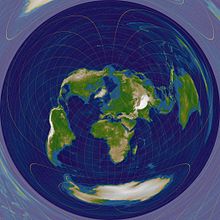Azimuthal Equidistant Projection
The azimuthal equidistant projection is a map projection in which the distance and direction of each dot is reproduced exactly at the center of map. It is not a projection in the optical sense, that is, there is no projection center.
It is used by radio services, for example. The antenna is at the point of contact, and you can easily determine the direction and the distance to your radio partner.
The map network design can depict the entire surface of the earth; the point opposite the point of contact forms a circle at which the projection surface is normally cut off. If you continue the illustration beyond this 180 ° edge, regions that have already been shown are shown again, albeit strongly distorted.
In the case of a polar position, the meridians are mapped as straight lines and the circles of latitude as circles. In a transverse or general position, the longitudes and latitudes form complex curves. These illustrations can no longer be constructed with compasses and ruler.
The north-south dimensions of the United Nations flag (along the meridians) are reminiscent of an azimuthal projection that is true to the center distance, but its west-east dimensions (along the parallels) are artistically corrected.
Point of contact: North Pole
Point of contact: South Pole
Point of contact: Canberra






